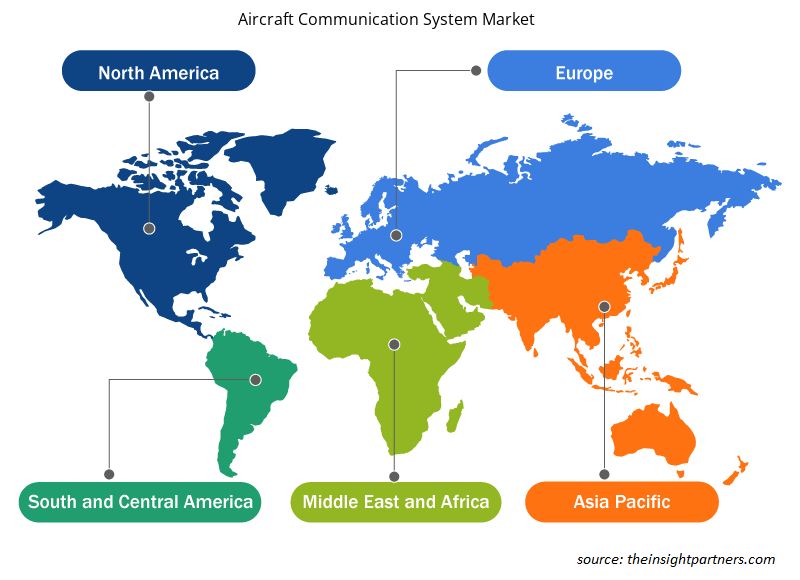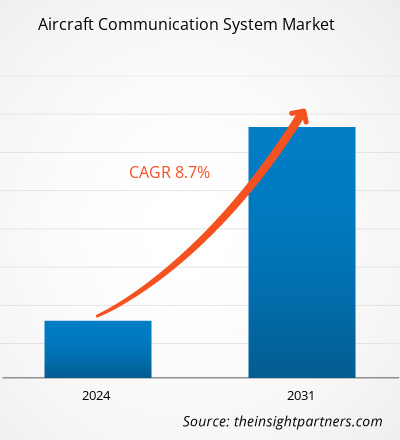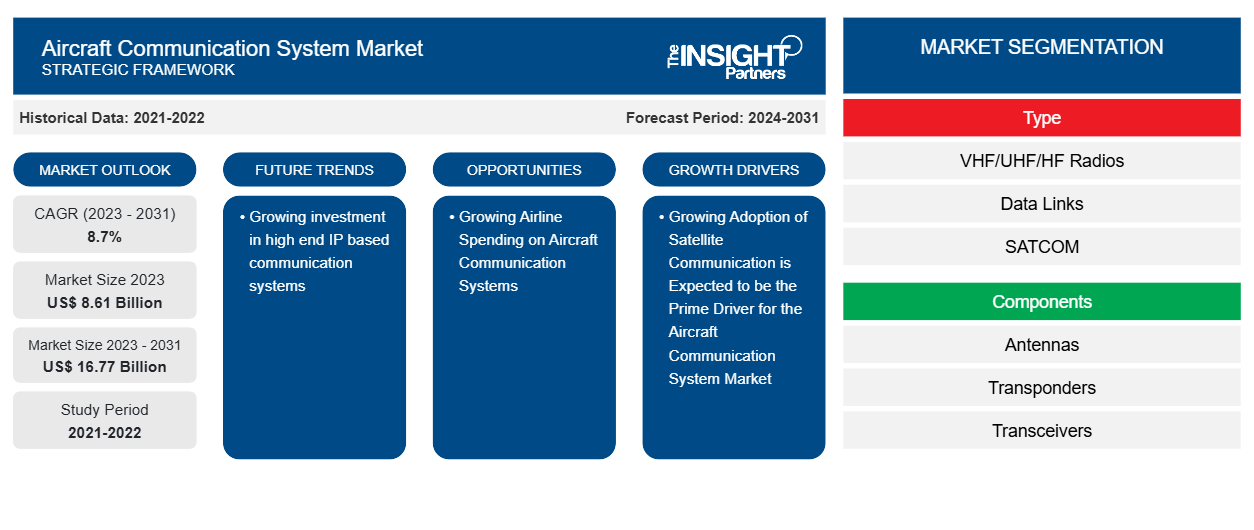항공기 통신 시스템 시장 규모는 2023년 86억 1,000만 달러에서 2031년까지 1,677억 달러로 성장할 것으로 예상됩니다. 이 시장은 2023~2031년에 8.7%의 CAGR을 기록할 것으로 예상됩니다. 실시간 정보, 데이터 교환 및 연결에 대한 증가하는 수요는 전 세계 항공기 통신 시스템 시장의 주요 원동력으로 작용하고 있습니다. SATCOM과 같은 고급 통신 시스템의 채택 증가는 승객 경험과 항공 교통 관리를 향상시키며, 이는 또한 전 세계 항공기 통신 시스템 시장의 주요 원동력으로 작용하고 있습니다.
항공기 통신 시스템 시장 분석
항공기 통신 시스템은 주로 항공기와 항공기 또는 지상 기지 간의 데이터 교환, 음성 전송, 실시간 정보 교환 및 수신에 활용됩니다. 항공기 통신 시스템은 위성 기반 항법 감시 경험을 향상시켜 항공기 통신 시장의 성장에 긍정적인 영향을 미칩니다. 대부분 항공기 통신 시장 공급업체는 무선 통신 기술과 고속 연결 궤적을 통한 항공 교통 관리와 같은 첨단 기술을 구현합니다. 이러한 주요 항공기 통신 시스템 공급업체는 군 및 상업용 함대를 위한 기술적으로 향상된 통신 시스템을 제작하기 위해 연구 개발 활동에 상당한 투자를 하고 있으며, 이는 예측 기간 동안 항공기 통신 시스템 시장의 발전을 촉진할 것으로 예상됩니다.
항공기 통신 시스템 시장 개요
항공 전자, 통신 인프라, 관리 제어 시스템의 기술적 발전은 항공기 통신 시장의 발전에 큰 영향을 미칩니다. 항공기 통신은 공중 사고의 발생을 상당히 줄이고 비상 시 통신 네트워크를 강화했습니다. 또한, 비행 시간과 항공 교통 관리의 복잡성을 줄이기 위한 위성 기반 항법 시스템의 상승 추세도 항공기 통신 시스템 시장의 성장을 촉진할 것으로 예상됩니다.
귀하의 요구 사항에 맞게 이 보고서를 사용자 정의하세요
이 보고서의 일부 또는 국가 수준 분석, Excel 데이터 팩을 포함하여 모든 보고서에 대한 사용자 정의를 무료로 받을 수 있으며 신생 기업 및 대학을 위한 훌륭한 혜택과 할인 혜택을 이용할 수 있습니다.
-
이 보고서의 주요 시장 동향을 알아보세요.이 무료 샘플에는 시장 동향부터 추정 및 예측까지 다양한 데이터 분석이 포함됩니다.
항공기 통신 시스템 시장 동인 및 기회
위성 통신 채택 증가는 항공기 통신 시스템 시장의 주요 원동력이 될 것으로 예상됩니다.
항공 산업의 증가하는 기술 발전은 위성 기반 통신 인프라의 적용을 촉진하고 있습니다. 위성 통신 네트워크를 구축하기 위한 소프트웨어 정의 무선의 확산은 항공기 통신 시스템 시장의 주요 원동력으로 작용하고 있습니다. 위성 통신 인프라는 함대와 지상 직원 간의 편리하고 원활한 연결 서비스를 위한 광범위한 네트워크 기술을 포함합니다. 유연성과 고속 연결은 위성 통신 시스템에 대한 수요를 촉진하고 있으며, 이는 전 세계 항공기 통신 시스템 시장의 주요 원동력으로 작용하고 있습니다.
항공기 통신 시스템에 대한 항공사 지출 증가
항공기 회사는 더 나은 운영 관리를 위해 고급 통신 시스템을 통합하는 데 주력하고 있습니다. 고급 항공기 통신 시스템은 비상 시 항공기 와 지상 기지 간의 적절한 연결을 편리하게 구축하는 데 도움이 됩니다. 또한 항공기 사상자 위험도 줄여줍니다. 비행 시간, 위치, 상태 및 제어와 관련된 실시간 데이터를 교환하는 것은 항공기 통신 시스템의 주요 속성입니다. 상업용 항공기의 경우 이륙 및 착륙 시 조종사와 지상 직원 간의 통신이 중요합니다. 또한 군용 또는 방위용 항공기도 목표 위치, 연료 상태, 함대 위치 및 중요한 임무 중심 정보와 같은 임무와 관련된 중요한 정보를 교환합니다. 항공 부문에서 통신 네트워크의 중요성이 커짐에 따라 예측 기간 동안 항공기 통신 시스템 시장이 성장할 것으로 예상됩니다.
항공기 통신 시스템 시장 보고서 세분화 분석
항공기 통신 시스템 시장 분석에 기여한 주요 세그먼트는 유형, 구성 요소 및 항공기 유형입니다.
- 항공기 통신 시스템 시장은 유형에 따라 VHF/UHF/HF 라디오, 데이터 링크, SATCOM으로 구분되었습니다. VHF/UHF/HF 라디오 부문은 2023년에 더 큰 시장 점유율을 차지했습니다.
- 구성 요소 측면에서 시장은 안테나, 트랜스폰더, 트랜시버, 디스플레이 및 프로세서로 세분화되었습니다. 트랜스폰더 세그먼트는 2023년에 시장을 지배했습니다.
- 항공기 유형 측면에서 시장은 상업용 항공기와 군용 항공기로 세분화되었습니다. 상업용 세그먼트가 2023년 시장을 지배했습니다.
지리적 지역별 항공기 통신 시스템 시장 점유율 분석
항공기 통신 시스템 시장 보고서의 지리적 범위는 주로 북미, 유럽, 아시아 태평양, 중동 및 아프리카, 남미의 5개 지역으로 나뉩니다.
북미는 2023년 항공기 통신 시스템 시장을 주도했습니다. 북미 지역에는 미국, 캐나다, 멕시코가 포함됩니다. 항공 부문의 첨단 기술과 무선 연결에 대한 높은 투자가 시장의 주요 원동력으로 작용하고 있습니다. 항공사와 주요 항공기 통신 시스템 제조업체의 높은 입지도 북미 항공기 통신 시스템 시장 성장을 견인하고 있습니다. 더욱 향상된 통신 인프라를 위해 상업용 및 방위 항공기의 기능을 개선하기 위한 항공 부문의 연구 개발 활동 증가가 북미 항공기 상업용 시스템 시장 성장을 견인하고 있습니다.
항공기 통신 시스템 시장 지역 통찰력
Insight Partners의 분석가들은 예측 기간 동안 항공기 통신 시스템 시장에 영향을 미치는 지역적 추세와 요인을 철저히 설명했습니다. 이 섹션에서는 북미, 유럽, 아시아 태평양, 중동 및 아프리카, 남미 및 중미의 항공기 통신 시스템 시장 세그먼트와 지리에 대해서도 설명합니다.

- 항공기 통신 시스템 시장에 대한 지역별 특정 데이터를 얻으십시오
항공기 통신 시스템 시장 보고서 범위
| 보고서 속성 | 세부 |
|---|---|
| 2023년 시장 규모 | 86억 1천만 달러 |
| 2031년까지 시장 규모 | 167억 7천만 달러 |
| 글로벌 CAGR (2023-2031) | 8.7% |
| 역사적 데이터 | 2021-2022 |
| 예측 기간 | 2024-2031 |
| 다루는 세그먼트 |
유형별로
|
| 포함된 지역 및 국가 |
북아메리카
|
| 시장 선도 기업 및 주요 회사 프로필 |
|
항공기 통신 시스템 시장 참여자 밀도: 비즈니스 역학에 미치는 영향 이해
항공기 통신 시스템 시장은 소비자 선호도의 변화, 기술 발전, 제품의 이점에 대한 인식 증가와 같은 요인으로 인해 최종 사용자 수요가 증가함에 따라 빠르게 성장하고 있습니다. 수요가 증가함에 따라 기업은 제품을 확장하고, 소비자의 요구를 충족하기 위해 혁신하고, 새로운 트렌드를 활용하여 시장 성장을 더욱 촉진하고 있습니다.
시장 참여자 밀도는 특정 시장이나 산업 내에서 운영되는 회사나 기업의 분포를 말합니다. 주어진 시장 공간에 얼마나 많은 경쟁자(시장 참여자)가 존재하는지 그 규모나 전체 시장 가치에 비해 나타냅니다.
항공기 통신 시스템 시장에서 운영되는 주요 회사는 다음과 같습니다.
- 허니웰 인터내셔널 주식회사
- 노스럽 그러먼 코퍼레이션
- 제너럴 다이내믹 코퍼레이션
- L3해리스 테크놀로지 주식회사
- 코브햄 주식회사
- 탈레스 그룹
면책 조항 : 위에 나열된 회사는 어떤 특별한 순서에 따라 순위가 매겨지지 않았습니다.

- 항공기 통신 시스템 시장 주요 주요 업체 개요를 알아보세요
항공기 통신 시스템 시장 뉴스 및 최근 개발
항공기 통신 시스템 시장은 1차 및 2차 조사 이후의 정성적, 정량적 데이터를 수집하여 평가되며, 여기에는 중요한 기업 간행물, 협회 데이터 및 데이터베이스가 포함됩니다. 다음은 항공기 통신 시스템 시장과 전략에 대한 시장의 개발 목록입니다.
- 2023년 8월, 노스럽 그러먼 코퍼레이션은 미 공군과 협력하여 화이트먼 공군 기지에서 B-2 스피릿으로 통합 공중 임무 이전(IAMT) 시연을 완료했습니다. (출처: 노스럽 그러먼 코퍼레이션, 보도자료/회사 웹사이트/뉴스레터)
- 2024년 4월 Thales Group은 Cobham Aerospace Communications를 인수하여 안전 조종석 커뮤니케이션 분야에서 입지를 강화했습니다. (출처: Thales Group, 보도자료/회사 웹사이트/뉴스레터)
항공기 통신 시스템 시장 보고서 범위 및 제공물
"항공기 통신 시스템 시장 규모 및 예측(2021-2031)" 보고서는 아래 영역을 포괄하는 시장에 대한 자세한 분석을 제공합니다.
- 범위에 포함된 모든 주요 시장 세그먼트에 대한 글로벌, 지역 및 국가 수준의 시장 규모 및 예측
- 동인, 제약 및 주요 기회와 같은 시장 역학
- 주요 미래 트렌드
- 자세한 PEST 분석
- 주요 시장 동향, 주요 업체, 규정 및 최근 시장 동향을 포괄하는 글로벌 및 지역 시장 분석
- 시장 집중도, 히트맵 분석, 유명 기업 및 최근 개발 사항을 포함하는 산업 환경 및 경쟁 분석
- SWOT 분석을 통한 자세한 회사 프로필
- 과거 분석(2년), 기준 연도, CAGR을 포함한 예측(7년)
- PEST 및 SWOT 분석
- 시장 규모 가치/거래량 - 글로벌, 지역, 국가
- 산업 및 경쟁 환경
- Excel 데이터세트
최근 보고서
사용 후기
구매 이유
- 정보에 기반한 의사 결정
- 시장 역학 이해
- 경쟁 분석
- 고객 인사이트
- 시장 예측
- 위험 완화
- 전략 기획
- 투자 타당성 분석
- 신흥 시장 파악
- 마케팅 전략 강화
- 운영 효율성 향상
- 규제 동향에 발맞춰 대응























 무료 샘플 받기 - 항공기 통신 시스템 시장
무료 샘플 받기 - 항공기 통신 시스템 시장